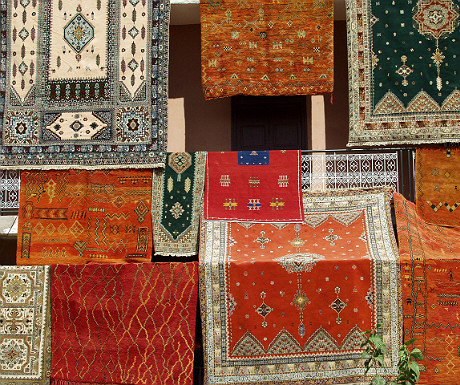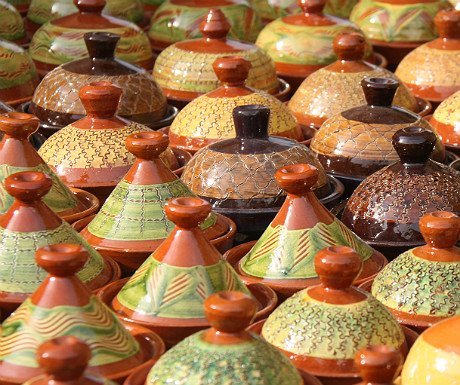The north of Morocco is barely 12km from the southern tip of Spain, so many Europeans make the crossing for a quick blast of north African retail therapy. Although everything can be bought in port cities such as Tangier, those in the know, prefer to tour the country making a bee-line for the regions that have great reputations for certain products.

First stop on the shopping trail is the Kif mountains. Here nestled between a pair of brooding peaks of dusty red sandstone, the blue-painted town of Chefchaoen shines like a sapphire. It is not only the walls of the houses, but the streets themselves that are painted in powder blue shades, creating a beautiful dreamlike scene. Shop here for great value locally produced blankets and other woollen goods known for their warmth, beauty and high level of craftsmanship. The same blanket will easily cost twice as much in Marrakesh.
However, before we get to Marrakesh, we should travel first to Fes and Meknes, two cities in the middle of the Moroccan plain that are renowned for both pottery and leather-crafts.
Bringing home a conical tajine pot is a bit of a tourist clich, but these pots are what the locals use to cook this traditional favourite. So tajine pots are clearly a sensible purchase if you are thinking about recreating the flavours of North Africa once you get home.

The traditional soft leather slippers or ‘babouches’ seen in every market are very comfortable to wear and worth trying for yourself. In Fes, the added attraction is going to see (and smell) the tanneries at the bottom of the souk where the leather is prepared in stone vats that have been in use since the middle ages. At the top of the market you will find lots of bread sellers and while I don’t know if Fes is particularly famous for bread, the best loaf I ever tasted was purchased here.
In Meknes, silver and gold shops seem to be everywhere so maybe you will be tempted to buy jewellery, but don’t overlook the humble soap sellers. Vegetarian soaps made with olive or argan oils and scented with a rich array of essential oils, herbs and spices are considered by the locals to be without equal.
So now we head for Marrakesh with it’s huge souk. Here chic shops nestle cheek by jowl with centuries old stalls making wrought iron goods, brass ware and musical instruments out on the street itself. The souk really is a shoppers paradise (particularly if you like Berber carpets), but there is a mix of high quality produce and low quality mass produced tat out there. Be led by your eyes, nose, hands and instincts. Take your time, block out the smooth tongued patter of the salesmen and decide for yourself if you are happy with the price. All this shopping will work up an appetite, and while you are in town I do recommend sampling the vast array of street food on the Djemaa el Fna, the huge market square in the heart of Marrakesh.
Throughout Morocco there are lots of stalls selling inlaid wooden boxes that really are very fine, but don’t buy them yet. Wait till you get to Essaouira on the Atlantic coast. This is where all these boxes come from and it is where the best quality examples are to be found. Made of deliciously scented thuja wood, inlaid with all manner of other trees in wonderful designs, these woodcrafts really are spectacularly good and buying them directly from the craftsmen who make them just adds to the pleasure.
Morocco is so much more than just a shopping destination, but for those of you who do want to bring home items as mementos and gifts, these tips will ensure you get the very best you can afford.